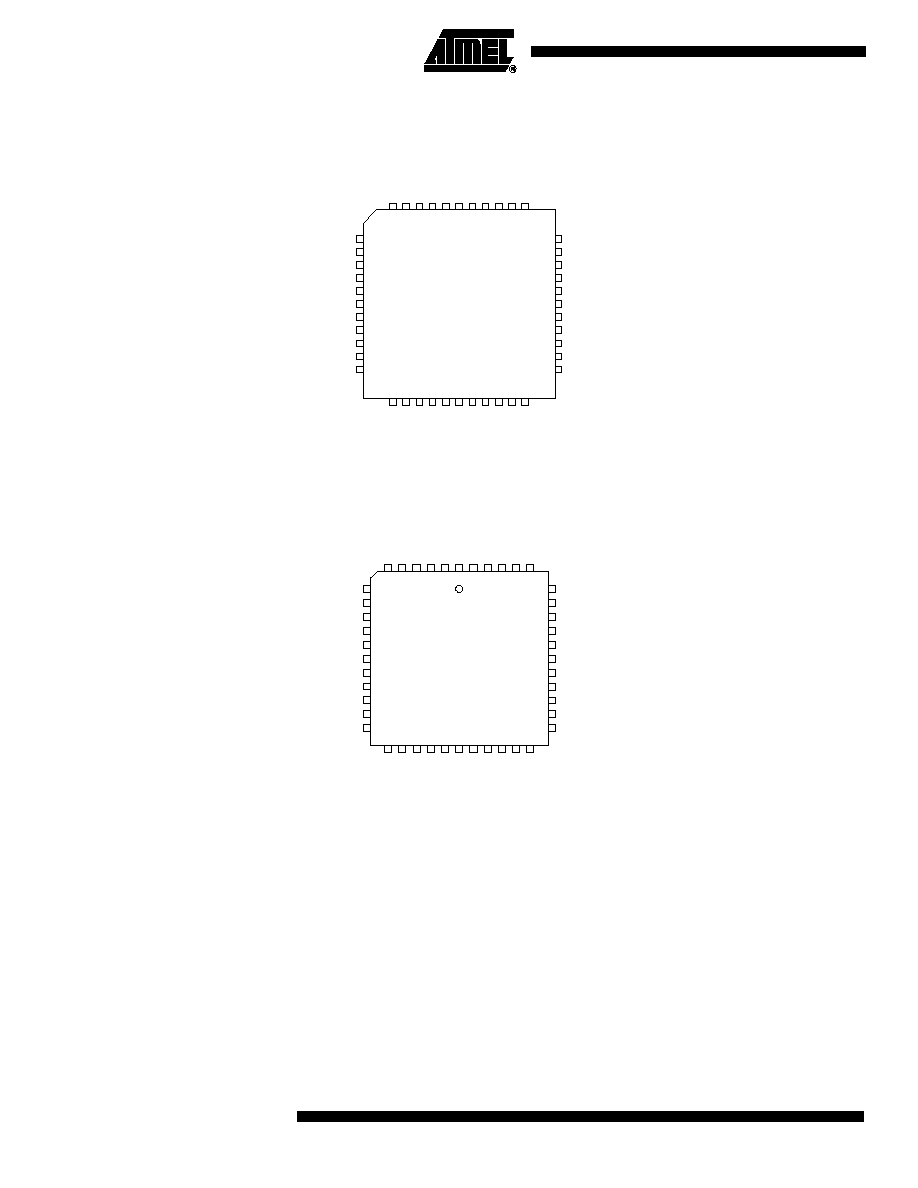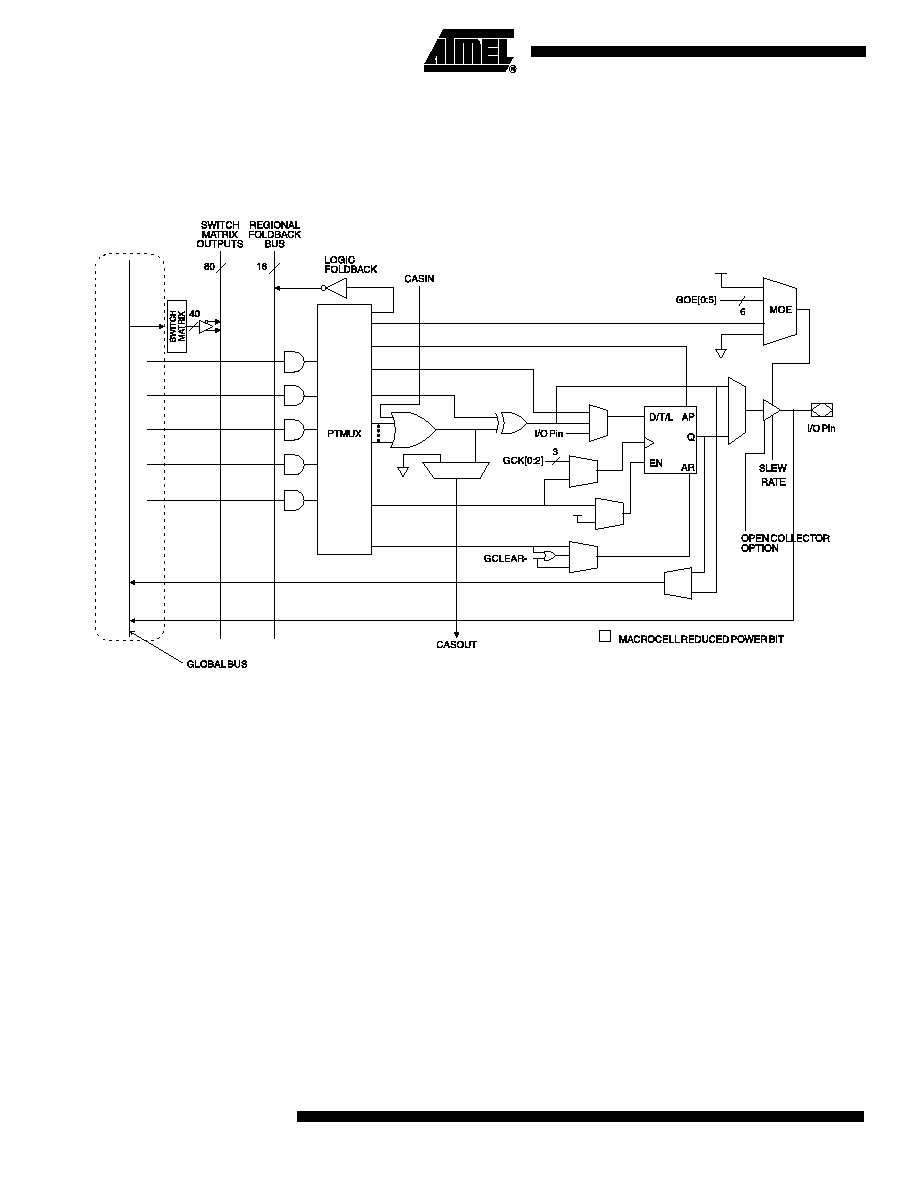
1
Features
·
High-density, High-performance, Electrically-erasable Complex Programmable
Logic Device
3.0 to 3.6V Operating Range
32 Macrocells
5 Product Terms per Macrocell, Expandable up to 40 per Macrocell
44 Pins
15 ns Maximum Pin-to-pin Delay
Registered Operation up to 77 MHz
Enhanced Routing Resources
·
In-System Programmability (ISP) via JTAG
·
Flexible Logic Macrocell
D/T Latch Configurable Flip-flops
Global and Individual Register Control Signals
Global and Individual Output Enable
Programmable Output Slew Rate
Programmable Output Open Collector Option
Maximum Logic Utilization by Burying a Register with a COM Output
·
Advanced Power Management Features
Pin-controlled 0.75 mA Standby Mode
Programmable Pin-keeper Inputs and I/Os
Reduced-power Feature per Macrocell
·
Available in Commercial and Industrial Temperature Ranges
·
Available in 44-lead PLCC and TQFP
·
Advanced EEPROM Technology
100% Tested
Completely Reprogrammable
10,000 Program/Erase Cycles
20-year Data Retention
2000V ESD Protection
200 mA Latch-up Immunity
·
JTAG Boundary-scan Testing to IEEE Std. 1149.1-1990 and 1149.1a-1993 Supported
·
PCI-compliant
·
Security Fuse Feature
Enhanced Features
·
Improved Connectivity (Additional Feedback Routing, Alternate Input Routing)
·
Output Enable Product Terms
·
D Latch Mode
·
Combinatorial Output with Registered Feedback within Any Macrocell
·
Three Global Clock Pins
·
Fast Registered Input from Product Term
·
Programmable "Pin-keeper" Option
·
V
CC
Power-up Reset Option
·
Pull-up Option on JTAG Pins TMS and TDI
·
Advanced Power Management Features
Individual Macrocell Power Option
High-
performance
EEPROM CPLD
ATF1502ASV
Rev. 1615HPLD2/04

2
ATF1502ASV
1615HPLD2/04
44-lead TQFP
Top View
44-lead PLCC
Top View
Description
The ATF1502ASV is a high-performance, high-density complex programmable logic
device (CPLD) that utilizes Atmel's proven electrically-erasable technology. With 32
logic macrocells and up to 36 inputs, it easily integrates logic from several TTL, SSI,
MSI, LSI and classic PLDs. The ATF1502ASV's enhanced routing switch matrices
increase usable gate count and the odds of successful pin-locked design modifications.
The ATF1502ASV has up to 32 bi-directional I/O pins and four dedicated input pins,
depending on the type of device package selected. Each dedicated pin can also serve
as a global control signal, register clock, register reset or output enable. Each of these
control signals can be selected for use individually within each macrocell.
1
2
3
4
5
6
7
8
9
10
11
33
32
31
30
29
28
27
26
25
24
23
I/O/TDI
I/O
I/O
GND
PD1/I/O
I/O
TMS/I/O
I/O
VCC
I/O
I/O
I/O
I/O/TDO
I/O
I/O
VCC
I/O
I/O
I/O/TCK
I/O
GND
I/O
44
43
42
41
40
39
38
37
36
35
34
12
13
14
15
16
17
18
19
20
21
22
I/O
I/O
I/O
I/O
GND
VCC
I/O
PD2/I/O
I/O
I/O
I/O
I/O
I/O
I/O
VCC
GCLK2/OE2/I
GCLR/I
I/OE1
GCLK1/I
GND
GCLK3/I/O
I/O
7
8
9
10
11
12
13
14
15
16
17
39
38
37
36
35
34
33
32
31
30
29
TDI/I/O
I/O
I/O
GND
PD1/I/O
I/O
I/O/TMS
I/O
VCC
I/O
I/O
I/O
I/O/TDO
I/O
I/O
VCC
I/O
I/O
I/O/TCK
I/O
GND
I/O
6
5
4
3
2
1
44
43
42
41
40
18
19
20
21
22
23
24
25
26
27
28
I/O
I/O
I/O
I/O
GND
VCC
I/O
PD2/I/O
I/O
I/O
I/O
I/O
I/O
I/O
VCC
GCLK2/OE2/I
GCLR/I
OE1/I
GCLK1/I
GND
GCLK3/I/O
I/O

3
ATF1502ASV
1615HPLD2/04
Block Diagram
Each of the 32 macrocells generates a buried feedback that goes to the global bus.
Each input and I/O pin also feeds into the global bus. The switch matrix in each logic
block then selects 40 individual signals from the global bus. Each macrocell also gener-
ates a foldback logic term that goes to a regional bus. Cascade logic between
macrocells in the ATF1502ASV allows fast, efficient generation of complex logic func-
tions. The ATF1502ASV contains four such logic chains, each capable of creating sum
term logic with a fan-in of up to 40 product terms.
The ATF1502ASV macrocell, shown in Figure 1, is flexible enough to support highly
complex logic functions operating at high speed. The macrocell consists of five sections:
product terms and product term select multiplexer, OR/XOR/CASCADE logic, a flip-flop,
output select and enable, and logic array inputs.
Unused product terms are automatically disabled by the compiler to decrease power
consumption. A security fuse, when programmed, protects the contents of the
ATF1502ASV. Two bytes (16 bits) of User Signature are accessible to the user for pur-
poses such as storing project name, part number, revision or date. The User Signature
is accessible regardless of the state of the security fuse.
The ATF1502ASV device is an in-system programmable (ISP) device. It uses the indus-
try standard 4-pin JTAG interface (IEEE Std. 1149.1), and is fully compliant with JTAG's
B
32

4
ATF1502ASV
1615HPLD2/04
Boundary-scan Description Language (BSDL). ISP allows the device to be programmed
without removing it from the printed circuit board. In addition to simplifying the manufac-
turing flow, ISP also allows design modifications to be made in the field via software.
Figure 1. ATF1502ASV Macrocell
Product Terms and
Select Mux
Each ATF1502ASV macrocell has five product terms. Each product term receives as its
inputs all signals from both the global bus and regional bus.
The product term select multiplexer (PTMUX) allocates the five product terms as
needed to the macrocell logic gates and control signals. The PTMUX programming is
determined by the design compiler, which selects the optimum macrocell configuration.
OR/XOR/
CASCADE Logic
The ATF1502ASV's logic structure is designed to efficiently support all types of logic.
Within a single macrocell, all the product terms can be routed to the OR gate, creating a
5-input AND/OR sum term. With the addition of the CASIN from neighboring macrocells,
this can be expanded to as many as 40 product terms with little additional delay.
The macrocell's XOR gate allows efficient implementation of compare and arithmetic
functions. One input to the XOR comes from the OR sum term. The other XOR input can
be a product term or a fixed high or low level. For combinatorial outputs, the fixed level
input allows polarity selection. For registered functions, the fixed levels allow DeMorgan
minimization of product terms. The XOR gate is also used to emulate T- and JK-type
flip-flops.

5
ATF1502ASV
1615HPLD2/04
Flip-flop
The ATF1502ASV's flip-flop has very flexible data and control functions. The data input
can come from either the XOR gate, from a separate product term or directly from the
I/O pin. Selecting the separate product term allows creation of a buried registered feed-
back within a combinatorial output macrocell. (This feature is automatically implemented
by the fitter software). In addition to D, T, JK and SR operation, the flip-flop can also be
configured as a flow-through latch. In this mode, data passes through when the clock is
high and is latched when the clock is low.
The clock itself can be either one of the Global CLK signals (GCK[0 : 2]) or an individual
product term. The flip-flop changes state on the clock's rising edge. When the GCK sig-
nal is used as the clock, one of the macrocell product terms can be selected as a clock
enable. When the clock enable function is active and the enable signal (product term) is
low, all clock edges are ignored. The flip-flop's asynchronous reset signal (AR) can be
either the Global Clear (GCLEAR), a product term, or always off. AR can also be a logic
OR of GCLEAR with a product term. The asynchronous preset (AP) can be a product
term or always off.
Extra Feedback
The ATF1502ASV macrocell output can be selected as registered or combinatorial.The
extra buried feedback signal can be either combinatorial or a registered signal regard-
less of whether the output is combinatorial or registered. (This enhancement function is
automatically implemented by the fitter software.) Feedback of a buried combinatorial
output allows the creation of a second latch within a macrocell.
I/O Control
The output enable multiplexer (MOE) controls the output enable signal. Each I/O can be
individually configured as an input, output or for bi-directional operation. The output
enable for each macrocell can be selected from the true or compliment of the two output
enable pins, a subset of the I/O pins, or a subset of the I/O macrocells. This selection is
automatically done by the fitter software when the I/O is configured as an input, all mac-
rocell resources are still available, including the buried feedback, expander and cascade
logic.
Global Bus/Switch Matrix
The global bus contains all input and I/O pin signals as well as the buried feedback sig-
nal from all 32 macrocells. The switch matrix in each logic block receives as its inputs all
signals from the global bus. Under software control, up to 40 of these signals can be
selected as inputs to the logic block.
Foldback Bus
Each macrocell also generates a foldback product term. This signal goes to the regional
bus and is available to four macrocells. The foldback is an inverse polarity of one of the
macrocell's product terms. The four foldback terms in each region allow generation of
high fan-in sum terms (up to nine product terms) with little additional delay.
Programmable Pin-
keeper Option for
Inputs and I/Os
The ATF1502ASV offers the option of programming all input and I/O pins so that pin-
keeper circuits can be utilized. When any pin is driven high or low and then subse-
quently left floating, it will stay at that previous high or low level. This circuitry prevents
unused input and I/O lines from floating to intermediate voltage levels, which causes
unnecessary power consumption and system noise. The keeper circuits eliminate the
need for external pull-up resistors and eliminate their DC power consumption.




